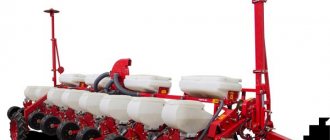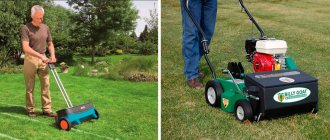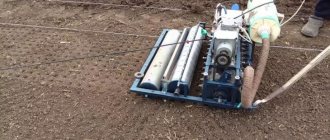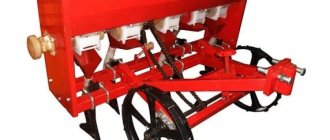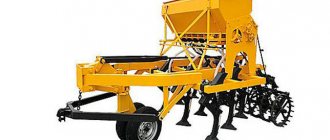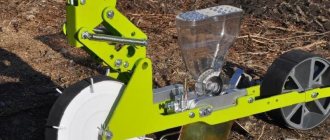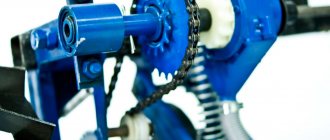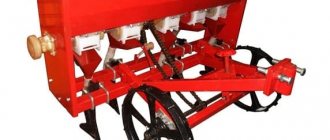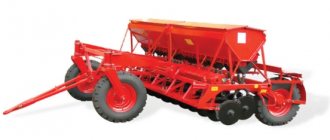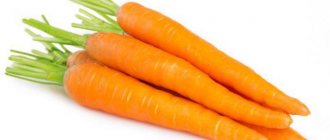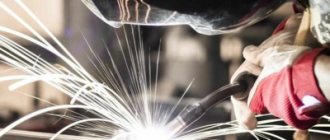UPS-8 Vesta device
In fact, this seeder is a metal frame with wheels and a hook. Bunkers for seeds and mineral fertilizers are installed on the frame. The UPS-8 Vesta seeder has a semi-automatic hitch, which allows it to be coupled with a tractor quickly and safely.
It is possible to move the seeder along the frame beam, thanks to which it is possible to sow with a row spacing of 450 mm with tractors on which the track cannot be adjusted. The frame also acts as a receiver, which makes it possible to achieve uniform vacuum in all hopper containers, and also removes unnecessary pulsations of air flows.
The frame, as well as the sowing section, copy the field topography in synchronous mode - due to the fact that the support wheels and grain coulters are placed on the same line. The wheels of the UPS-8 seeder are equipped with special treads with lugs, which helps prevent slipping and ensure consistently uniform intervals between seeds.
The seeder fan is equipped with additional air ducts, and thanks to this, the seeding discs retain the seeds much better. It is possible to regulate the air flow using dampers, and an overrunning clutch is used to protect the belt drive, which is always subject to increased wear. Thanks to the viewing window, you can monitor the quality of sowing, as well as adjust the sowing device even more precisely.
You can adjust the offset of the system that applies mineral fertilizers, which allows you to minimize the negative impact of fertilizers on seeds. Special rolling rollers improve contact between seeds and moisture at the bottom of the furrow, which optimizes conditions for seed growth and development.
There is an additional modification of this agricultural machine - UPS-8 Vesta PROFI, also on the market, which is equipped with the Sputnik information device. This device allows you to monitor the operation of the seeder, determine the rate and uniformity of sowing, the presence of gaps and doubles in each section, the distribution of seeds throughout the field or in individual rows.
Features of the UPS-8 Vesta seeder
This pneumatic precision seeding technology is used for dotted line seeding of both calibrated and non-calibrated seeds. It is suitable for planting a wide variety of crops: sunflower, soybeans, corn, beans, lupine, beans, castor beans, sorghum.
Together with the seeds (or separately from them), using the universal pneumatic seeder UPS-8, you can apply mineral and other granular fertilizers to the soil. The seeder is used to consolidate the soil in the rows after planting. When planting uncalibrated seeds, sowing may have some inaccuracy, the degree of which depends on the size and damage of the seed.
The seeders of the UPS Vesta family treat planting material with the utmost care. Compared to mechanical models, there are ten times less seed fragmentation. Also, the Vesta precision planting pneumatic seeder guarantees the required distance between crop plants.
The speed at which sowing can take place varies from 3.5 to 9 km/h. Accordingly, depending on the speed, the productivity of the seeder also changes - ranging from 2 hectares per hour to 5.04 hectares per hour. In this case, seeds can be planted to a depth of 40 to 120 mm.
Technical characteristics of Vesta 8 and 12 seeders
When choosing a UPS 8 and 12 seeder, you should pay attention to their technical characteristics. More detailed technical characteristics for both models can be viewed in the table:
Seeders are produced in Ukraine. Similar models are produced in St. Petersburg and Rostov-on-Don. The certificate for the Vesta model range, which includes UPS 8 and 12, belongs to the Ukrainian ones. You can buy a seeder in any region of Russia; there will be no problems with spare parts either. And with proper use, the equipment will last at least 10 years. Equipment warranty from the manufacturer is 1 year.
Recently, the UPS8 model has been upgraded to 8-02. The 8-02 seeder is distinguished by the additional equipment of a seed sowing controller. Its technical characteristics are presented in the table below:
Design of UPS-8 Vesta
The seeder shafts are secured with rolling bearings. The grain drive and fertilizer drive also have movable fasteners. The musculoskeletal wheels are located on an axle running next to the grain coulters. This helps the seeder to effectively follow the relief of the natural landscape of the fields.
The UPS-8 seeder also includes a transport device, which makes it possible to transport this agricultural equipment without the involvement of additional equipment.
The UPS-8 Vesta seeder comes standard with discs for corn and sunflower. This model also comes with a hydrated marker with a disc of significant diameter. It leaves a noticeable mark on the field, thanks to which the machine operator can always see where the sowing was done. It also allows you to change the angle of attack.
Tedders and comb ejectors are placed on the calling disks. They ensure accurate drinking and placement of seeds into the soil. For crops with heavy seeds that require vacuum (in particular, legumes), a fan with an additional air outlet is used.
As noted earlier, the seeder frame beam plays the role of a receiver for the pneumatic system of the UPS-8 seeder, reduces the pulsation of the air flow, which helps to obtain uniform seeding in each section.
The comb seed twin ejector ensures precise single grain sowing. A tedder is installed on the sowing disc. The sowing device produces precise single-grain sowing of seeds of various crops with a seeding rate from 2 to 43 pcs. at p.m. To quickly remove seeds from the chamber of the sowing apparatus, there is an unloading hatch. A vault breaker is installed in the seed hopper to prevent the seeds from hanging.
The UPS-8 Vesta seeder uses an anchor coulter, which primarily works using classical technology, which means that it involves preliminary preparation of the soil for sowing. It performs very well in different conditions and does not clog on waterlogged and sticky soils.
The UPS-8 Vesta seeder can be equipped with replaceable openers for sowing corn and sunflower seeds and openers for sowing beets.
The equipment of Chervona Zirka (formerly Krasnaya Zvezda), an enterprise with a 130-year history in the former USSR, ensured harvests in 56 countries. Having such a solid biography and truly unique experience, it develops and introduces into production a wide range of universal agricultural products. equipment that successfully competes with domestic and imported analogues. In 2004 JSC "Chervona Zirka" ensured an increase in production volumes by 40%, and the model range was expanded to 90 units. The company's quality management system is certified according to ISO 9001 standards.Being a monopolist in the production of row-crop seeders in the USSR, Chervona Zirka OJSC in new market relations continues to maintain a leading position among manufacturers of this group of sowing equipment. In the mid-70s. Simple and reliable seeders SUPN-6, SUPN-8, SST-12, SON-4.2 have gained wide popularity among rural producers specializing in the cultivation of row crops and vegetables. However, the emergence of new agricultural cultivation technologies. crops set the plant the task of developing and mastering the serial production of a new generation of row crop seeders with a higher technical level. Since 2004, the plant has stopped producing outdated models of seeders SUPN-8, SUPN-6, SUPN-8-0I, SUPN-6-01, SST-12V, replacing them with more reliable, high-performance and versatile UPS-12, UPS-8, UPS-6, SUPN-8A, SUPN-8A-01, SUPN-8A-02, SUPN-6A, SUPN-6A-01 and SUPN-6A-02.
To objectively assess the technical level of new machines, it is necessary to consider in more detail the differences in their design from the “old” models. Let's start with a comparison of the basic models of corn seeders "old" SUPN-8 and the new SUPN-8A, which have completely different designs of sowing units, sowing sections, frames, fans, etc.
1. The SUPN-8A seeder uses rolling bearings in the drive of sowing devices for grain and fertilizers (on the SUPN-8 seeder, sliding bearings made of metal-ceramics or polymer materials were installed), which significantly increased the reliability, durability and quality of operation of the seeder as a whole,
2. The fan of the SUPN-8A seeder (more powerful than that of the SUPN-8 seeder) is driven from the tractor PTO (540 rpm), which ensures a stable and sufficient vacuum in the pneumatic system. Previously, the quality of its work largely depended on the quality of the tractor’s hydraulic system, which did not always meet the requirements.
3. In the SUPN-8 seeder, one combined coulter was used in the sowing section for applying mineral fertilizers and sowing grain, which did not exclude the possibility of contact between seeds and fertilizers (and this is undesirable) after they are embedded in the soil. The SUPN-8A seeder has two separate coulters for planting fertilizers and seeds with the ability to change the interval between the row of fertilizers and the sown row of grain.
4. The support-drive wheels of the SUPN-8A seeder, due to their larger diameter than those of the SUPN-8 (708 and 510 mm), roll easier, and thanks to the “all-terrain” tire tread, they slip less, which ensures a more accurate distribution of seeds along the row.
5. The SUPN-8A seeder is equipped with a more powerful marker (welded structure made of square pipes 42 x 42 mm) with a spherical disk of larger diameter (400 mm versus 300 mm for the SUPN-8 seeder) and a variable angle of “attack”, which leaves a clearly visible trace on the field, allowing the machine operator to clearly maintain butt row spacing when sowing.
6. Design of the SUPN-8A seeder depending on the technology of sowing agricultural crops. crops allows you to change row spacing from 700 to 450, 600 and 900 mm (the SUPN-8 seeder does not have this ability).
7. The presence of a transport device in the SUPN-8A seeder (the SUPN-8 seeder does not have one) ensures convenient and quick delivery to the sowing site, as well as the possibility of storing machines in covered premises, thereby increasing their durability.
8. Since 2004, SUPN-8A seeders have been produced with seeding devices in which the intermediate chain drive has been eliminated (chain pitch 12.7 mm), which has significantly increased the reliability of the seeding device and the seeder as a whole.
9. The use of a receiver in the pneumatic system of the SUPN-8A seeder made it possible to reduce the difference in vacuum in the chambers of the sowing devices located at different distances from the fan. In the SUPN-8 seeder, due to the different lengths of the air ducts (especially in the outer sections), a drop in vacuum was observed in the sowing units, which negatively affected the quality of their work.
10. Pneumatic devices of the SUPN-8A seeder can be converted into mechanical ones using the “Device for soybean sowing”, in which seeds are sown by a reel without vacuum. The SUPN-8 seeder does not have this capability.
Based on the above, the SUPN-8A seeder and its modifications have significant advantages over the SUPN-8 seeder both in terms of operational reliability and seeding quality.
In order to most fully satisfy the wishes of agricultural consumers. technology based on the SUPN-8A seeder, the plant produces a range of seeders with different consumer properties (Table 1).
Instead of the beet seeder SST-12V, the plant mass-produces the universal pneumatic seeder UPS-12, which is designed for sowing seeds of sugar and fodder beets (both regular and coated seeds), corn, sunflower, castor beans, sorghum, broad beans, beans and soy.
The SST-12V seeder had the following disadvantages:
- high requirements for the quality of seed (in terms of its calibration). With poor seed calibration, the percentage of “doubles”, omissions and damaged seeds increased sharply;
- a mechanical device crushes up to 3% of seeds during operation (for a pneumatic device this figure is 10 times less);
- high percentage of shell damage in coated seeds;
- low speed of the unit (up to 5 km/h) when sowing at final density;
- The seeder is equipped with discs for each seed fraction.
The main advantages of the UPS-12 seeder include:
1. The versatility of the machine. In addition to sowing seeds of sugar and fodder beets, it provides sowing of seeds of corn, sunflower and other crops thanks to the configuration with replaceable discs and openers;
2. Ability to change row spacing from 450 to 600, 700 and 900 mm;
3. For quick and convenient emptying of the seed hopper and sowing apparatus from seed material, a special hatch is provided in the design of the sowing apparatus;
4. The comb ejector of “excess” seeds ensures more stable operation of the sowing apparatus for single-grain seed sowing compared to the fork type;
5. A special agitator in the neck of the seed hopper prevents arching, while ensuring a constant supply of seeds with poor flowability to the sowing apparatus;
6. The increased diameter of the sowing disk (compared to the disks of the SUPN-8 and SUPN-8A seeders) made it possible to place more holes on it, which in turn made it possible to reduce its rotation speed while ensuring the specified seed sowing rate (pcs/linear m) ;
7. The viewing window located in the rear part of the sowing apparatus allows you to observe the sowing process when adjusting the ejector of “excess” seeds;
8. The rear V-shaped compaction roller ensures soil compaction on both sides of the sown row, leaving a loose layer above the seeds for better germination. In addition, the soil mound formed above the sown row prevents the formation of a crust after precipitation;
9. The design of the seeder allows for the possibility of shifting the three-point hitch when working with tracked tractors (for example, T-70S), whose track width is not adjustable.
For those farms that are not engaged in the cultivation of beets, on the basis of the UPS-12 seeder, “corn” seeders UPS-8 and UPS-6 have been developed and are commercially produced (Table 2).
In 2001, UPS-12, as the best domestic seeder, received the “Highest Standard” sign, in 2002 - a certificate of conformity from UkrSEPRO, in 2003-2004. - silver medals at the Moscow International Exhibition “Golden Autumn”.
Today, the share of UPS-12 seeders in the fleet of domestic pneumatic beet seeders reaches 20%.
Table 1 Indicators SUPN-6A SUPN-6A-02 SUPN-8A-01 SUPN-6A-01 SUPN-8A SUPN-8A-02
Number of sowing sections 6 6 6 8 8 8 Design of the pneumatic system: - fan driven by the tractor PTO ( 540 min-1) + — + + — + — gas jet compressor operating due to the ejection of exhaust gases from a tractor engine — + — — + — Availability of a transport device + — — + — — Number of sets of replaceable discs for sowing seeds of various crops 12 5* 5* 12 5* 5* Availability of a device for sowing soybean seeds + — — + — — Tractor class 1.4 1.4 1.4 1.4/2 1.4/2 1.4/2 ——— ———- * By separate order it is possible to purchase the required number of sets.
Table 2 Indicators UPS-12 UPS-8 UPS-6 UPS-12-01 UPS-8-01 UPS-6-01
Number of sowing sections 12 12 8 8 6 6 Availability of equipment for applying mineral fertilizers + — + — + — Availability of transport devices + + + + + + All row-crop seeders produced by Chervona Zirka OJSC can be equipped with a new generation seeding control system "Niva-23" (Ukraine, Poltava), which provides comprehensive information about the quality of operation of each seeding unit and seeder generally. Using the Niva-23 seeding control system, you can obtain the following information:
- about the seeding rate (pcs/m) in each section;
- about the percentage of doubles and omissions in each section;
- about the uniformity of seeding in each section;
- about the distribution of seeds (% and cm) along the row;
- about the distribution of seeds (% and cm) over the entire area;
- about the operating time of the seeder and the sown area;
- about the speed of movement of the unit;
- about the results of self-test of the control system condition;
- about reaching the lower level of seeds and fertilizers in one of the bunkers (on request);
- about the results of sowing over the entire field area.
In addition, Niva-23 calculates and stores the percentage of slip of the drive wheel of the seeder after “calibrating” the path.
Information about how sowing was carried out on the entire field is stored in non-volatile memory for 5 years (5 fields of 500 hectares each) and allows for a detailed and substantive analysis of the process. In terms of price-quality ratio, factory-made machines (all serial products are certified) have repeatedly won tenders for supply to different countries.
For the development of new products and achievement of high quality, Chervona Zirka OJSC was awarded the international award “European Quality”.
The plant has its representative offices not only throughout Ukraine, but also in the CIS countries. An extensive dealer network has been created. Due to the wide network of technical centers, each buyer can receive advice on the operation of seeders, quickly and efficiently carry out warranty repairs and service maintenance of machines bearing the Chervona Zirka brand.
Setting up the UPS-8 Vesta seeder for seeding rates and preparing it for work
The rotation speed of the tractor power take-off shaft is set to 540 rpm. Next, the marker offset is established, either experimentally or by calculation. It is convenient to navigate along the marker trail by running the front left wheel of the tractor along it.
The UPS-8 Vesta seeder is adjusted to the seeding rate by selecting a disk suitable for the required crop and seeding rate. The greater the distance between adjacent plants in a row, the fewer holes in the disk. The diameter of the holes depends on the cultivated crop: the larger the seeds, the larger the holes.
Then, according to the tables, based on the seeding rate and the desired speed of movement of the tractor, the required combination of drive sprockets is selected and installed. By turning the drive wheel of the seeder manually, it is ensured that only one seed is sucked into each hole in the disc.
A special adjustment spring adjusts the pressure of each section on the soil. This is required to prevent coulters from jumping, as well as excessive pressure on the ground, leading to wear on the seeder and additional consumption of diesel fuel. The pressure of a section on the soil depends on the topography of the field and can be approximately considered normal when the section can be manually torn off the ground with an average muscular effort.
The deepening mechanism does not require complex settings. The seed placement depth is set on a scale by rotating the adjusting screw.
The fertilizer sowing unit is adjusted to the fertilizer application rate by selecting and installing a specific set of drive gears. The gears are selected according to the table, based on the seeding rate and the speed of the tractor, and are simply installed and secured with cotter pins.
Features of working with UPS-8 Vesta seeders
The advantages of all seeding units of the Vesta family include:
- the possibility of simultaneously applying a specified amount of fertilizer along with sowing;
- rolling the row after sowing is a good way to provide the seeds with moisture at the initial stage of their development;
- the use of a vacuum seed capture device prevents losses caused by damage to the seed;
- durability of all rotating mechanisms - due to the fact that preference is not given to rotation according to the “hole-axis” scheme, and almost all rotating parts of the machine are equipped with rolling bearings;
- the possibility of sowing using classical technology, including when working on sticky and (or) waterlogged soils.
When applying fertilizers along with sowing, the UPS-8 Vesta seeder processes seven hectares without additional loading (at a corn sowing rate of 5 seeds per 1 linear meter). The system for applying fertilizers through fertilizer coulters makes it possible to apply mineral fertilizers away from the row, with the required amount of displacement, which prevents the harmful effects of fertilizers on the seeds.
Fertilizer bins are equipped with special plastic bushings that prevent any accidental spillage of mineral fertilizers. And to remove residues there is an unloading hatch in the bunker.
To improve seed placement and stability of sowing sections when operating precision seeders, wide rolling, rakes and a trailing rail are used in the sections. Rolling the soil in sown rows improves contact between seeds and moist soil at the bottom of the furrows, guarantees capillary rise of moisture and creates favorable conditions for earlier and more favorable seed germination.
UPS-8 Vesta seeders are equipped with an electronic control system FACT, which controls the passage of seeds in each coulter, the speed of movement and transmits information to the monitor in the tractor cabin. This helps to keep track of sown areas.
Pneumatic grain-fertilizer seeder (Vesta)
Designed for dotted sowing of calibrated and uncalibrated seeds of corn, sunflower, castor bean, sorghum, soybeans, as well as seeds of broad beans, beans, lupine with simultaneous application of granular mineral fertilizers separately from the seeds and rolling the soil in rows. It is also possible to sow uncalibrated seeds, but in this case the accuracy will directly depend on the size and degree of damage of the seed.
Precision seeding drills provide seeding at the final density, eliminating the use of manual labor when forming the required interval between plants. Equipping the seeder with a transport device allows it to be transported along public roads without the use of additional vehicles.
In 2012, the seeder was modernized. From September 1, 2012, all seeders are supplied with a sowing section equipped with a 2-circuit drive of a new design. along which the drive is located significantly higher, which, together with the new protection, ensures work in fields clogged with plant debris.
Pneumatic sowing devices of precision seeders reduce the percentage of seed crushing by 10 times compared to mechanical ones.
All drive shafts of grain and fertilizer sowing units are mounted on rolling bearings.
Due to the location of the axis of the support wheels in line with the grain coulters, synchronous copying of the field topography is achieved by both the frame and the sowing section.
The lug tread on the road wheel tires reduces their slippage, which ensures a specified interval between seeds.
The seeders are equipped with a durable hydraulic marker with a larger diameter disk, which has the ability to change the angle of attack to obtain a clearly visible mark.
Equipping the seeder with a transport device allows it to be moved along public roads without the use of additional vehicles.
The semi-automatic hitch ensures a quick and safe connection of the seeder with the tractor; the hitch can be moved along the frame beam, which allows sowing with a row spacing of 450 mm with tractors whose track width does not change (for example, T-70S).
To create a uniform vacuum required when sowing heavy seeds of legumes (soybeans, etc.), the fan is equipped with an additional air duct. The seeder frame beam is a receiver for the seeder pneumatic system; it reduces the pulsation of the air flow, which allows for uniform seeding in each section.
The fan is equipped with an overrunning clutch that protects the belt drive from increased wear.
The presence of an observation window allows for visual monitoring of the quality of operation of the sowing apparatus during the setup process.
The comb seed twin ejector ensures precise single grain sowing. A tedder is installed on the sowing disc.
The sowing device produces precise single-grain sowing of seeds of various crops with a seeding rate from 2 to 43 pieces per linear meter.
To quickly remove seeds from the chamber of the sowing apparatus, an unloading hatch is provided. A vault breaker is installed in the bunker, which prevents the seeds from hanging.
The fertilizer sowing system through fertilizer coulters makes it possible to apply mineral fertilizers away from the row with the required amount of displacement, which eliminates the harmful effects of fertilizers on seeds.
Plastic bushings are installed in the fertilizer bunker, which prevent the arbitrary spillage of mineral fertilizers. To remove residual mineral fertilizers, an unloading hatch is provided in the fertilizer bunker.
To improve seed placement and stability of sowing sections when operating corn seeders, the section uses wide rolling, rakes and a trailing rack.
Rolling the soil in sown rows improves contact between seeds and moist soil at the bottom of the furrows, provides capillary rise of moisture and creates favorable conditions for earlier and more favorable seed germination.
Gas exchange occurs due to open zones.
Reviews from agricultural producers about the UPS-8 Vesta seeder
The UPS-8 Vesta seeder does not like clogging of sowing units or careless organization of off-season storage. Its vacuum mechanism is not very sensitive to seed calibration, but does not like seed contamination.
According to reviews from farmers, the UPS-8 Vesta seeder is characterized by decent reliability. It does not fail with breakdowns, it can withstand seeding norms. The advantages of this seeder are the very convenient comb cutter, which leaves as many seeds as needed. And also a powerful and reliable chain.
The UPS-8 Vesta seeder is specifically addressed to small and medium-sized agricultural producers. A large one will most likely prefer to take a more advanced imported seeder.
But in general, the seeder of this model is a modern and successful option for small agro-industrial and farm enterprises.
